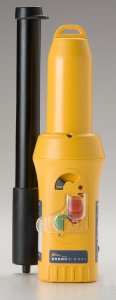Search-and-Rescue Transponders
A Search-and-Rescue Transponder (SART) is a radar transponder, which after
having been triggered by a received radar signal will respond with the
transmission of a burst of radar signals.
The radar response will be visible on the screen of the radar that
triggered the SART.
As part of the GMDSS, SART devices are used to locate a survival craft
or distressed vessel by generating a trace of dots on a rescuing ship's
radar display where the nearest dot to the center indicates the position
of the transponder within 150 m.
The transponder is an aid to home vessels or rafts during search and rescue operations.
Technical Details
|
A SART operates on the 9 GHz X-band (3 cm wavelength; 9.2-9.5 GHz) and will
only respond to an X-band radar.
It will not be seen on the S-band (10 cm wavelength) or any other radar frequency.
The SART device may be triggered by any X-band radar signal within a range of
approximately 8 nautical miles.
Each radar pulse received causes it to transmit a response which
consists of a number of sweeps across the X-band.
When activated, the transponder first sweeps rapidly (0.4 microsecond) through
the band and continues with a slower sweep (7.5 microseconds) back to the
starting frequency.
This process is repeated for a total of twelve complete cycles.
At some point in each sweep, the SART frequency will match that of
the interrogating radar and be within the pass band of the radar receiver showing
a dot on the radar display.
|


 |
|
If the SART is within range, the frequency match during each of the 12 slow
sweeps will produce a response on the radar display. This will result in a
line of 12 dots equally spaced by about 0.64 nautical mile (300000km/s times 7.9us
total sweep-time divided by two due to the time-to-distance scaling of the radar).
These dots are quite distinctive, and stand out from the normal radar responses -
giving the search vessel both the bearing and range to the SART.
If the range to the SART is within a couple of nautical miles,
the radar display may show also the 12 responses generated during the fast sweeps.
These additional dot responses, which also are equally spaced by 0.64
nautical mile, will be interspersed with the original line of 12 dots.
They will appear slightly weaker and smaller than the original dots.
As the SART is approached, the side lobe sensitivity of the radar antenna may
result in showing the SART responses as a series of arcs or even concentric
rings.
These can be removed by the use of the gain or anti-clutter sea control.
However, it may be operationally useful to observe the side lobe signals as
they may be easier to detect in conditions and also they will confirm that
the SART is near to the own ship. |
The diagrams below show the expected responses at approximately 12 miles,
6 miles, and 2 miles.

When looking for a SART on the radar, it is preferable to use either the
6 or 12 nautical mile range scale.
This is because the total displayed length of the SART response of 12 (or 24)
dots may extend approximately 9.5 nautical miles beyond the position
of the SART and it is necessary to see a number of response dots to
distinguish the SART from other responses.
If only responses from the 12 low frequency sweeps are visible
- when the SART is at a range greater than about 1 nautical mile, the position
at which the first dot is displayed may be as much as 0.64 nautical
mile beyond the true position of the SART.
If the range closes so that the fast sweep responses are seen also,
the first of these will be no more than 150 metres beyond the true
position.
The detection range between these devices and ships, dependent upon the
height of the ship's radar mast and the height of the SART, is normally
about eight nautical miles.
Note that a marine radar may not detect a SART even within this distance,
if the radar settings are not optimized for SART detection.
Especially the settings for anti-clutter sea and rain control must be
set correctly to obtain optimal detection performance of SART signals.
Typical SART Specifications
| Type: |
Search and Rescue Transponder (SART), transmitting on 9.2 - 9.5 GHz
Color: International distress orange. |
|---|
| |
| Approval: |
Approved by every major maritime nation around the world |
|---|
| |
| Operating conditions: |
-30°C to +65°C (stored)
-20°C to +55°C (operational) |
|---|
| |
| Battery: |
Capacity: 96 hours on standby, followed by 8 hours operational.
Type: Lithium |
|---|
| |
| Receiver Response: |
9.2 - 9.5 GHz, sensitivity better than -50dBm |
|---|
| |
| Transmitter Response: |
12 forward and return sweeps through the range 9.2 to
9.5 GHz. Nominal sweep times 7.5 us forward and 0.4us
return. Minimum recovery time following excitation, less
than 10 us. Response reply to receiver signal less than 0.5 us. |
|---|
| |
| Radiated Power: |
Not less than 400 mW (+26 dBm)
|
|---|
| |
| Antenna Characteristics: |
Vertical beam width at least ±12.5 degree relative to
the horizontal plane of the radar transponder to ±2 dB.
Azimuthal beam width omnidirectional to ±2 dB. |
|---|
| |
| Dimensions: |
Length: 300 mm
Diameter: 40 mm
Lanyard: 10 meters
Weight: 950 g (without bracket) |
|---|
|



